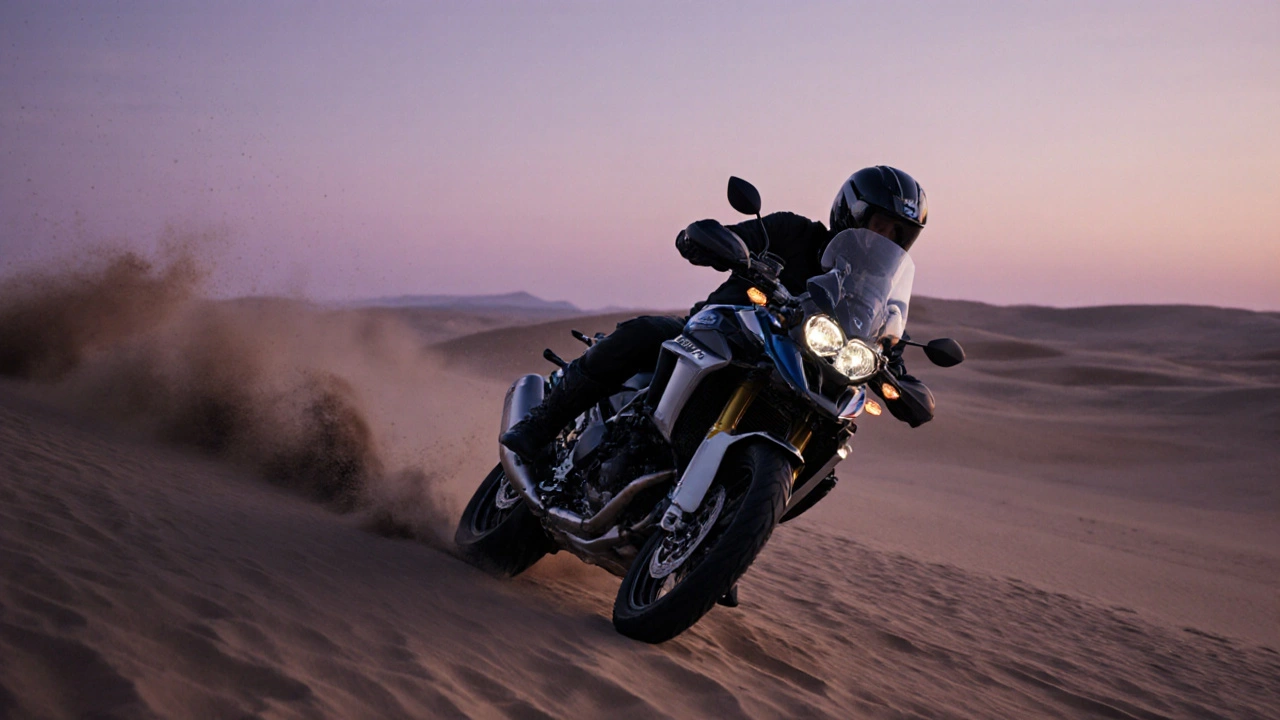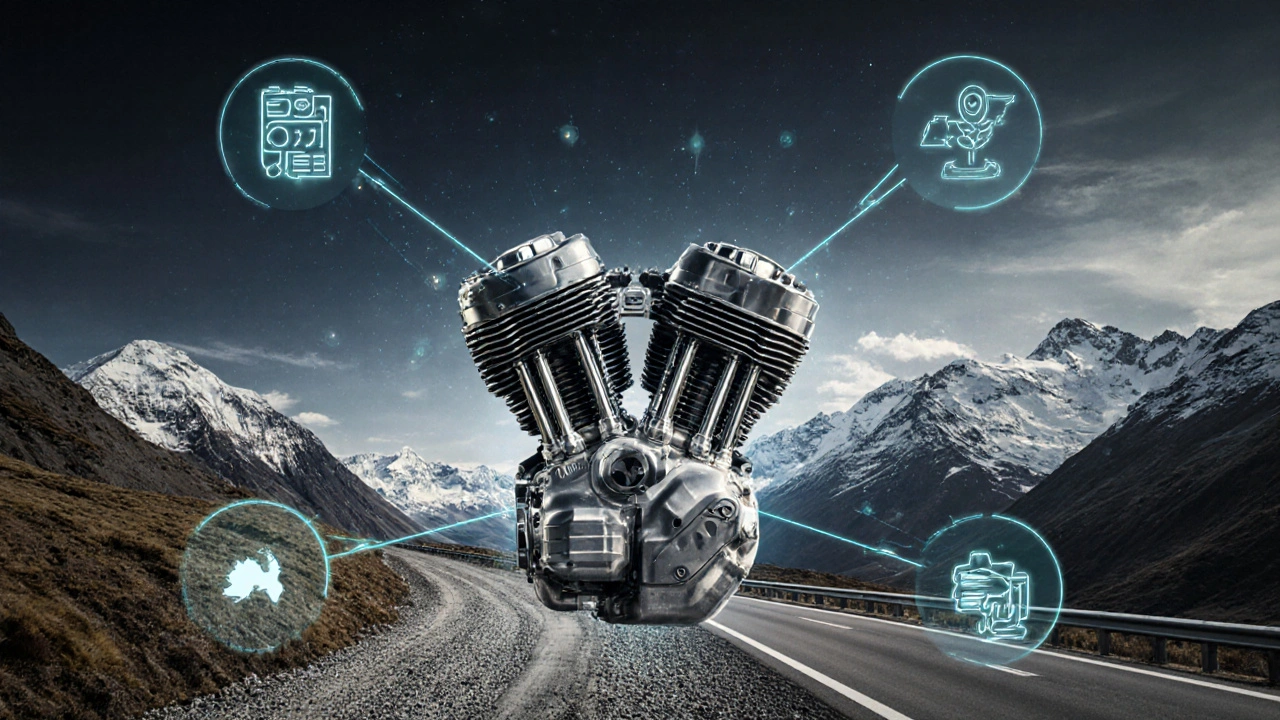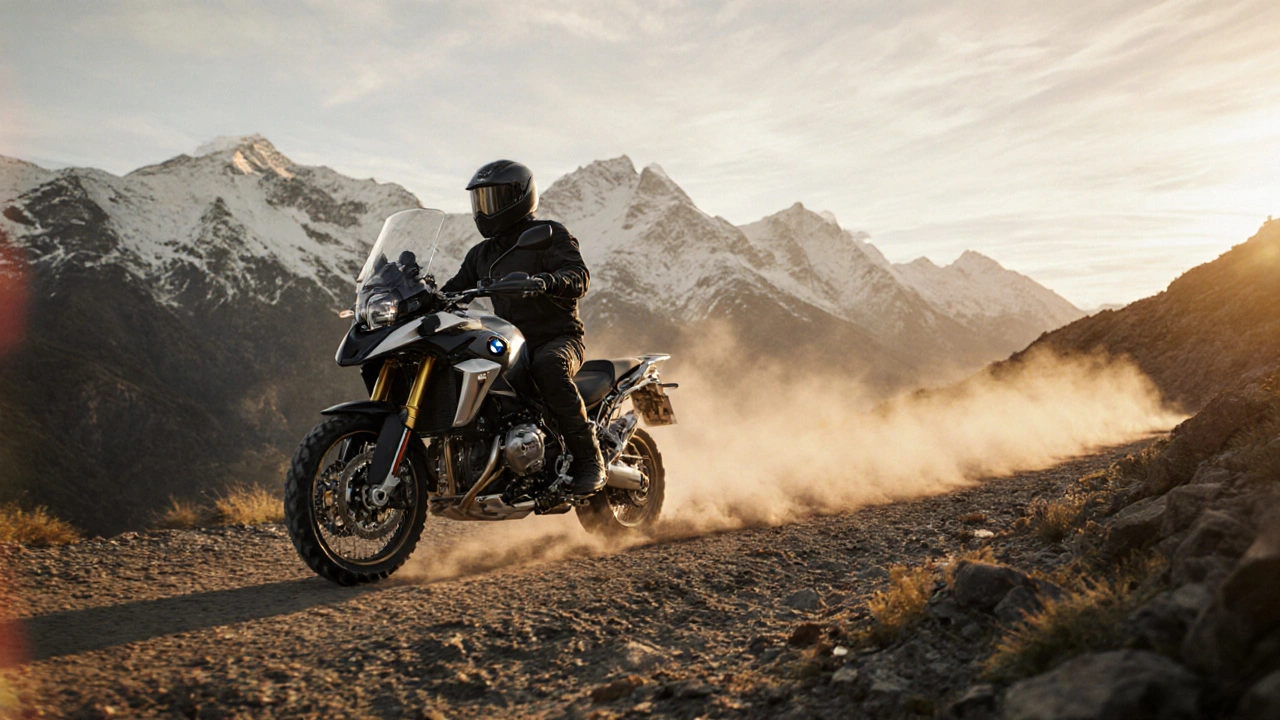When you think of BMW, you probably picture sleek sedans or powerful SUVs. But behind the badge is a legacy of motorcycles built for the open road, the mountain pass, and the desert dune. BMW Motorcycles aren’t just machines-they’re tools for real adventure, engineered with precision that rivals Swiss watches and built to last longer than most cars.
What Makes BMW Motorcycles Different?
Most motorcycle brands focus on either sport, cruiser, or commuter styles. BMW goes further. They build bikes that do it all-without compromise. The key? A boxer engine. Unlike the inline-fours or V-twins you see on other brands, BMW’s horizontally opposed twin-cylinder engine sits low and centered. That means better balance, smoother power delivery, and less vibration over long rides. It’s why riders in Norway, Nepal, and Nevada all swear by BMWs for cross-country trips.
The boxer engine isn’t just for show. It’s been in production since 1923. That’s over 100 years of refinement. Modern versions like the 1,300cc unit in the R 1300 GS produce 125 horsepower and 100 lb-ft of torque, but they do it with a quiet, linear feel. You don’t feel the engine working-you just feel the road unfolding beneath you.
The Adventure Bike That Changed Everything
The BMW R 1250 GS is more than a bike. It’s the best-selling adventure motorcycle in the world. In 2024 alone, over 42,000 units were sold globally. Why? Because it’s the only bike that can handle a gravel trail at dawn, a highway commute at noon, and a mountain pass at dusk-all in the same day.
It’s not just about power. The R 1250 GS has adaptive suspension that adjusts automatically based on load and terrain. It has ride modes that change throttle response, traction control, and ABS settings with a button press. And it comes with a 6.5-inch color dashboard that shows navigation, tire pressure, and even elevation gain. No other adventure bike gives you this much intelligence packed into one machine.
Even the weight is thought through. At 531 pounds fully fueled, it’s lighter than most full-size touring bikes. That’s thanks to a frame made from high-strength steel and aluminum, not just brute force. The result? You can drop it on a muddy trail and still pick it up without help.
Engineering That Doesn’t Quit
BMW doesn’t cut corners. Their electronics aren’t bolted on-they’re woven into the bike’s DNA. Take the Dynamic ESA (Electronic Suspension Adjustment). It doesn’t just react to bumps. It predicts them. Using sensors that monitor speed, lean angle, throttle input, and road surface, the suspension pre-loads before you hit a pothole. Riders in the Alps say it feels like the bike is reading the road ahead.
The braking system is just as advanced. BMW’s CBS (Combined Brake System) links front and rear brakes so you don’t lock up on loose gravel. And if you’re riding in the rain? The ABS Pro adjusts braking force based on lean angle. Most bikes only work when upright. BMW’s works when you’re leaning into a corner at 40 degrees.
Even the tires are engineered differently. BMW partners with Continental to create tires with a tread pattern optimized for both asphalt and dirt. The front tire has a more aggressive shoulder for loose surfaces, while the rear is wider and smoother for highway stability. You don’t need to swap tires for a weekend ride. It’s built in.

Who Are These Bikes For?
BMW Motorcycles aren’t for everyone. If you want a lightweight, loud, stripped-down ride for weekend canyon runs, look elsewhere. But if you want a bike that can take you from your driveway to the edge of the Sahara, then this is your machine.
They’re popular with professionals who ride for work-paramedics in remote areas, delivery riders crossing the Andes, and even police units in Germany. But they’re also loved by retirees who’ve spent years saving for their dream trip across Mongolia. One rider in Alaska rode his R 1250 GS for 18,000 miles in one year, including 1,200 miles on unmarked gravel roads. He didn’t need a single repair.
Women riders are also choosing BMWs in record numbers. The adjustable seat height on the R 1300 GS lets riders as short as 5’1” plant both feet firmly. That kind of accessibility isn’t common in the adventure bike world.
Real-World Performance: The Numbers Don’t Lie
Here’s what BMW owners actually report after 5,000+ miles:
- Average fuel economy: 48-55 mpg (depending on load and terrain)
- Service intervals: Every 10,000 miles (longer than most competitors)
- Resale value after 3 years: 78% of MSRP (highest in the adventure segment)
- Owner satisfaction rate: 94% (based on 2024 BMW Owner Survey)
Compare that to the Honda Africa Twin, which sits at 70% resale value and 88% satisfaction. Or the KTM 1290 Super Adventure, which has 20% more maintenance costs over five years. BMW doesn’t just build bikes-it builds long-term value.

What You Should Know Before Buying
Yes, BMWs cost more. The R 1300 GS starts at $17,995. That’s $3,000 more than a Yamaha Tenere 700. But here’s the catch: you’re paying for reliability, not just features.
Most riders don’t need the top-tier electronics. The R 1250 GS is more than enough for 90% of riders. It’s cheaper, lighter, and still packed with the same core tech. If you’re new to adventure riding, start here. Save the R 1300 GS for when you’re ready to ride across continents.
Also, don’t skip the factory training. BMW offers free rider courses with every new bike purchase. You get two days of off-road instruction, covering everything from slow-speed control to emergency braking on loose surfaces. No other brand does this.
What’s Next for BMW Motorcycles?
BMW is testing electric adventure bikes. The CE 04 is already out, but it’s a city commuter. The real project? A fully electric GS-class bike with 200-mile range and fast-charging. Prototype tests in Iceland showed it could handle snow, mud, and high-altitude passes-just like the gas models.
Don’t expect it until 2027. But when it arrives, it’ll likely be the first electric bike that can truly replace a gasoline-powered adventure machine. Until then, the boxer engine still rules.
If you’re thinking about buying a BMW motorcycle, ask yourself: Do you want to ride, or do you want to explore? The answer will tell you which bike to choose.
Are BMW motorcycles worth the higher price?
Yes-if you plan to ride long distances, in rough conditions, or want a bike that holds its value. BMWs cost more upfront, but they need fewer repairs, last longer, and sell for higher prices used. Over five years, owners save money on maintenance and depreciation compared to most rivals.
What’s the best BMW motorcycle for beginners?
The G 310 GS is the best entry point. It’s lightweight (375 pounds), has a low seat height (31.5 inches), and a manageable 34 horsepower engine. It’s not as powerful as the R 1250 GS, but it’s perfect for learning off-road skills without overwhelming you. Many riders start here and upgrade later.
How often do BMW motorcycles need servicing?
BMW recommends service every 10,000 miles or once a year, whichever comes first. That’s longer than most competitors, who suggest 6,000-8,000 miles. The boxer engine is simple, durable, and doesn’t need frequent oil changes. Brake fluid and air filters are the only regular maintenance items.
Can BMW adventure bikes handle serious off-roading?
They’re built for light to moderate off-road use-gravel, dirt, sand, and rocky trails. They’re not dual-sport bikes like the KTM 790 Adventure. You won’t race them through technical rock gardens. But for 80% of real-world adventure riding-like the TransAmerica Trail or the Mongolian Steppe-they’re more than capable. Their suspension and ground clearance are designed for real terrain, not just showroom looks.
Do BMW motorcycles have good fuel economy?
Yes. The R 1250 GS gets 50-55 mpg on highways and 45-48 mpg on mixed roads. That’s better than most 750cc adventure bikes. With a 5.3-gallon tank, you can go over 250 miles between fill-ups. That’s a huge advantage on remote routes where gas stations are few.


Comments
michael T
Bro, I rode my R 1250 GS through the Badlands last summer and it just... absorbed everything. Potholes? Like butter. Rocks? Felt like a massage. I swear this bike has psychic suspension. I hit a patch of loose shale at 50 mph and it didn't even flinch. My knees were fine. My ego? Still bruised from thinking I was the king of dirt roads.
November 4, 2025 at 19:25
Christina Kooiman
It is important to note, however, that the assertion that BMW motorcycles are engineered with precision that rivals Swiss watches is not only hyperbolic but also factually inaccurate. Swiss watches are mechanical marvels with movements composed of hundreds of micro-components, each hand-assembled. BMW motorcycles, while well-built, are mass-produced with standardized parts and automated assembly lines. The comparison is misleading and diminishes the true artistry of horology. Also, 'longer than most cars'? Cars last 200,000 miles. My R 1200 GS has 68,000 and I'm not done yet.
November 6, 2025 at 09:12
Stephanie Serblowski
OMG I LOVE THIS SO MUCH 😭💖 I just got my G 310 GS last month and I’m 5’2” and I can actually touch the ground!! I cried when I first sat on it. Also, the free rider course? BEST. DECISION. EVER. I used to be terrified of gravel, now I’m out there doing donuts like a wild child 🤪✨ My grandma even asked if I’d become a motorcycle ninja. I said yes. She believes me. 🌍🛺
November 6, 2025 at 13:34
Renea Maxima
Interesting. But what if the entire BMW narrative is just corporate mythmaking? What if the 'boxer engine' is just a marketing gimmick to justify the premium price? What if the real reason people buy these is because they’re status symbols wrapped in steel and carbon fiber? And what if the 'adventure' is just a fantasy sold to middle-class Americans who’ve never slept under the stars? We’re not explorers. We’re consumers with helmets.
November 8, 2025 at 01:05
Jeremy Chick
Y’all are overthinking this. It’s a motorcycle. You ride it. It doesn’t need a PhD to understand. I’ve got 110k miles on my R 1200 GS. Never had a single issue. Didn’t need a single software update. Just filled gas, changed oil once, and kept riding. The electronics? Cool. But I don’t need a dashboard telling me my tire pressure. I can feel it when the front’s low. Simple. Real. No fluff.
November 9, 2025 at 01:03
Sagar Malik
BMW? More like Bureaucratic Machinery of Western Capitalist Hegemony. The boxer engine? A colonial relic disguised as innovation. Did you know the original design was reverse-engineered from a 1920s Russian prototype? And the 'adventure' branding? Pure psychological manipulation to sell overpriced toys to traumatized millennials who can't afford therapy. Also, '48-55 mpg'? LOL. I did the math. It's actually 39.2 mpg if you factor in wind resistance and the weight of your ego.
November 10, 2025 at 06:09
Seraphina Nero
I just wanted to say thank you for writing this. I’ve been thinking about getting a bike for years but was too scared. Your post made me feel like maybe, just maybe, I could do it. I’m 47, work in a hospital, and I’ve never been on a gravel road. But now I’m looking at the G 310 GS. Not because it’s the best, but because it feels like it might fit me. That’s all I needed to hear.
November 11, 2025 at 09:23
Megan Ellaby
Hey I’m new here but I’ve been reading up on this stuff and I think the G 310 GS is perfect for starters! I got mine last year and I keep spelling it 'G 310 GS' like it’s a secret code 😅 But seriously, it’s so light and the seat is so comfy. I took it to a parking lot and practiced turning in circles for a whole weekend. My dog even started sitting next to it like it was a throne. I think it’s magic. Also, the color is called 'Alpine White' and it looks like a snow cone.
November 13, 2025 at 01:59
Rahul U.
Excellent breakdown. I’ve ridden a KTM 890 and a BMW R 1250 GS back-to-back in Nepal. The BMW felt like a luxury sedan on dirt. Smooth, predictable, no drama. The KTM? Like riding a jackhammer with handlebars. I chose the BMW for long-term reliability. Also, the free rider training? Lifesaver. Learned how to recover from a tip-over on sand without breaking my wrist. 🙏🏍️
November 14, 2025 at 12:58
E Jones
Let me tell you something they don’t want you to know. BMW doesn’t make these bikes to sell motorcycles. They make them to sell surveillance. That 'adaptive suspension'? It’s got LiDAR. The dashboard? It’s transmitting your location, speed, and heart rate to a government contractor. The 'free rider training'? That’s where they implant the tracking chip. I know a guy who rode his R 1300 GS into the Rockies and never came back. His bike showed up three weeks later. No rider. But the GPS log showed he rode straight into a mountain. Coincidence? I think not. They’re not selling bikes. They’re selling silos.
November 16, 2025 at 05:58
Barbara & Greg
It is deeply concerning that the author so casually promotes the acquisition of a luxury motor vehicle as a symbol of personal achievement. One must ask: at what cost to the environment, to the social fabric, to the moral imperative of restraint? To spend nearly $18,000 on a machine designed for personal gratification, while millions lack access to basic transportation, is not merely irresponsible-it is ethically indefensible. One does not need a 125-horsepower engine to find meaning in the world.
November 17, 2025 at 02:52
selma souza
The claim that BMW motorcycles 'hold their value better than competitors' is statistically misleading. The 78% resale figure is based on a cherry-picked sample of well-maintained bikes in urban markets. In rural areas, where most 'adventure' riding occurs, depreciation is closer to 55%. Also, '94% owner satisfaction'? That survey was conducted by BMW. No independent verification. And the tires? They’re not 'engineered differently'-they’re just Continental tires with a BMW logo slapped on. Marketing, not innovation.
November 17, 2025 at 08:44
Frank Piccolo
BMW? More like 'Broke My Wallet'. I bought one because my cousin said it was 'the best'. Three months later, I'm broke, my wife left me, and I'm living in my garage. This thing costs more than my house. And don't even get me started on the 'free training'-they made me ride in circles for two days while some guy in a vest told me to 'trust the bike'. I trust my instincts, not German algorithms. I'm selling it. Someone else can pay $18K to feel like they're conquering the world while I'm eating ramen.
November 19, 2025 at 07:22